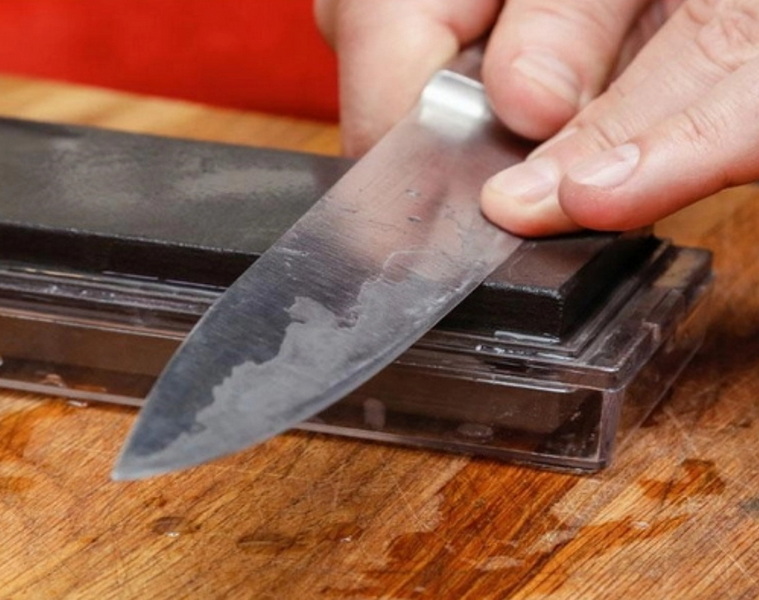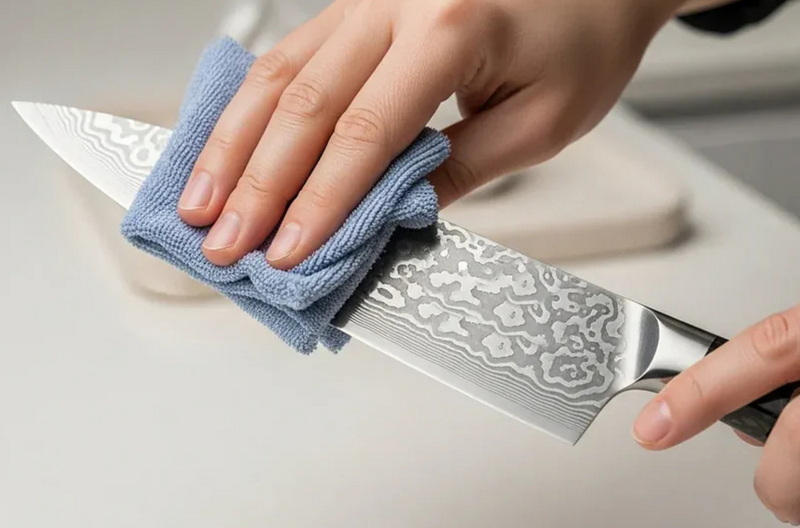- All
- Product Name
- Product Keyword
- Product Model
- Product Summary
- Product Description
- Multi Field Search
Views: 222 Author: Ann Publish Time: 2025-10-15 Origin: Site











Content Menu
● Why Proper Maintenance Matters
● Cleaning Your Damascus Knife
● Using Your Damascus Knife Correctly
● Sharpening Your Damascus Knife
>> Tools You Need for Sharpening
>> Sharpening Process Step-by-Step
● Caring for the Damascus Pattern
● Additional Tips for Damascus Knife Longevity
● FAQs
>> 1. How often should I oil my Damascus knife?
>> 2. Can I use a dishwasher for my Damascus knife?
>> 3. What grit stones are best for sharpening Damascus knives?
>> 4. How do I prevent rust on my Damascus knife?
>> 5. Should I sharpen my Damascus knife myself or seek a professional?
Damascus knives are celebrated not only for their exquisite beauty but also for their superior cutting performance. Crafted from layered steel, these knives combine artistry and function. As a Chinese kitchen knife factory providing OEM services to international brands, understanding how to maintain and sharpen Damascus knives is crucial. Proper care preserves the blade's sharpness, enhances durability, and maintains the signature appearance of the steel's intricate patterns.

Damascus steel contains a significant amount of carbon, which grants it hardness and sharpness but also makes it sensitive to moisture and corrosive substances. Without proper care, the blade can develop rust, tarnish, lose its shine, or suffer damage to its unique layered pattern. Since Damascus knives often feature beautiful, artistic layered designs, protecting both the performance and aesthetics is important.
- Immediate Cleaning: Always clean your Damascus knife promptly after each use to prevent acids and food residues from damaging the steel. Citrus juices, salts, and acidic sauces can erode the blade if left on too long.
- Hand Wash Only: Use warm water, mild dish soap, and a soft sponge or cloth to clean the blade. Avoid abrasive scrubbers, steel wool, or harsh detergents that can scratch or wear down patterns and protective layers.
- Avoid Dishwashers: Dishwashing detergents combined with high heat and moisture can accelerate rusting and damage the blade's surface.
- Dry Thoroughly: Moisture is the enemy of Damascus steel. Immediately dry the blade completely with a soft towel after washing. If possible, let it air dry fully before storing.
- Regularly applying a thin layer of food-grade mineral oil or specialized knife oils helps form a barrier to moisture and protects against oxidation.
- Light oiling after each use, especially if you don't intend to use the knife again soon, prolongs the lifespan of the blade.
- Avoid heavy coatings or cooking oils that can become sticky or rancid.
- Wax-based protectants designed for knives can also be used periodically for enhanced protection.
- Store your Damascus knife in a dry, temperature-stable environment.
- Use a wooden or bamboo knife block, magnetic knife strip, or individual protective sheaths made of fabric or plastic. Leather sheaths are generally discouraged as they can retain moisture and cause corrosion from tanning chemicals.
- Avoid cluttered drawers or environments with fluctuating humidity to minimize risk of damage.
- If you live in a humid area, consider storing your knives with silica gel packs or dehumidifiers nearby.
- Use cutting boards made from wood, bamboo, or plastic to reduce blade damage.
- Avoid cutting on hard surfaces such as glass, ceramic, metal, or stone that dull the blade rapidly.
- Do not use your Damascus knife to cut frozen foods, bones, or other excessively hard materials.
- Avoid twisting or prying motions while cutting, which can chip or damage the delicate edge.
- Regularly check and address any edge damage early to keep the knife performing optimally.

Sharpening Damascus knives requires special care to maintain the blade's performance and preserve its intricate patterns. A properly sharpened knife performs better, lasts longer, and keeps the beauty of the Damascus steel intact.
- Whetstones: Use water stones or oil stones with grit levels from 1000 to 3000 for sharpening edges; stones with 5000 to 8000+ grit are ideal for fine polishing.
- Honing Steel: Use frequently to realign the knife's edge between major sharpening sessions.
- Leather Strop: To remove burrs and refine the edge for a razor-sharp finish.
- Angle Guide: Magnetic angle guides help maintain a consistent edge angle during sharpening to avoid uneven wear.
1. Prepare the Whetstone: Soak water stones in water for 10-15 minutes or apply oil to oil stones as per manufacturer instructions.
2. Maintain the Correct Angle: Hold the blade at around 15-20 degrees relative to the stone (15° is typical for sharper, more delicate edges; 20° for tougher knives).
3. Sharpen Evenly: Push or pull the knife across the stone in smooth, controlled strokes, covering the entire blade edge evenly to avoid uneven sharpness.
4. Flip and Repeat: Sharpen both sides of the blade equally until a burr forms along the edge, signaling the metal is being properly reshaped.
5. Use Higher Grits for Polishing: After initial sharpening with medium grit stones, move to finer stones (5000 grit and above) to polish the edge and restore shine.
6. Honing and Stropping: Regularly hone to realign edge teeth and use a leather strop to remove any remaining burrs for a mirror finish.
7. Test Sharpness: Carefully test edge sharpness by slicing paper or gently toward the skin (without harm).
- Using pull-through sharpeners that can damage the carefully crafted layered steel.
- Applying excessive force or aggressive strokes that cause chips or uneven edges.
- Sharpening only one side, which will wear the blade unevenly.
- Using a coarse grit stone excessively, which removes too much metal and shortens blade life.
- Overheating the blade with mechanical sharpeners or grinding wheels, which weakens the temper of the steel.
The Damascus steel's signature aesthetics come from the layered folding process, resulting in distinctive flowing or wavy patterns on the blade. Protecting this visual feature requires special care:
- Do not use abrasive household cleaners, scrubbing pads, or steel wool on the blade surface to preserve the etching.
- For stubborn stains or to refresh the blade's pattern, gentle acid etching with diluted vinegar or lemon juice followed by polishing can restore contrast.
- Use specialized polishing compounds made for Damascus knives to enhance the layered pattern's depth.
- Periodic professional restoration can re-establish lost patina and polishing.
- Avoid prolonged exposure to salty or acidic foods without cleaning, as they accelerate corrosion.
- Regularly inspect the knife for any signs of oxidation or rust and address immediately by cleaning and oiling.
- Consider applying a light coat of wax for long-term storage, especially in humid climates.
- Always cut on appropriate surfaces and avoid any usage that stresses the blade mechanically.
Damascus knives combine centuries-old craftsmanship with modern cutting performance, deserving careful maintenance and sharpening to preserve their functionality and breathtaking beauty. Regular handwashing, drying, light oiling, and careful storage help maintain the blade's condition, while proper sharpening using whetstones, honing steels, and stropping ensures long-lasting sharpness. Protecting the signature layered pattern with gentle cleaning and polishing enhances the knife's aesthetic appeal. By mastering these care techniques, you can enjoy your Damascus knife as a reliable culinary tool and a stunning work of art for many years.

Apply a thin layer of food-safe oil weekly if used regularly, or monthly if stored.
No. Dishwashers damage the blade with harsh detergents, heat, and moisture.
Use 1000-3000 grit stones for sharpening and 5000+ grit for polishing.
Keep it clean and dry, oil regularly, and store in a dry place.
With the right tools and care, self-sharpening is possible. Otherwise, professional sharpening ensures safety and precision.
The Ultimate Professional Knives for Halal Butchery in Middle Eastern Kitchens
Chef Knife Size Guide: Choosing Between 6″, 8″, 10″, And 12″
Custom Knife Handles: How To Design A Chef Knife That Fits Your Hand Perfectly
Chef Knife Surface Treatments Guide: From Polished Migaki To Damascus Patterns
Inside Our Professional Knife Sample Room: Quality You Can See
Universal Knife Block Buying Guide: Modern Acrylic & ABS Knife Holders for Professional Kitchens
Universal Knife Block: The Complete Guide To Modern, Hygienic Knife Storage
The Complete Guide To Red Handle Knife Sets: Style Meets Functionality in The Kitchen
Professional Knives for Halal Butchery And Middle Eastern Cuisine